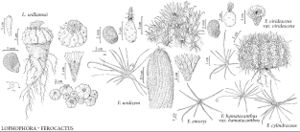Ferocactus viridescens var. viridescens
Stems erect, oblate to spheric (to short cylindric), usually 10–20(–45) × 10–20(–35) cm; ribs 13–21[–34], shallowly notched immediately above each areole. Spines 10–19 per areole, central spines and larger radial spines pink or yellowish, smallest spines per areole slender, sometimes bristlelike, less than 1 mm diam. (rarely absent); central spines 4 per areole, straight or slightly curved, annulate, thin and flattened, narrowly elliptic in cross section, principal central spine 30–50 × 2–3(–5) mm. Flowers 2.5–5 × 3–6 cm, color similar inside and out; inner tepals greenish yellow, sometimes with reddish brown midstripes; stigma lobes yellow. Fruits ± readily dehiscent through basal pore, bright yellow (very rarely reddish), 20–35 × 15–25 mm, leathery or fleshy, locule dry, hollow except for seeds. Seeds 1.5–1.7 mm, pitted. 2n = 22.
Phenology: Flowering spring–early summer.
Habitat: Rocky coastal bluffs, coastal chaparral
Elevation: 0-200 m
Distribution

Calif., Mexico (Baja California).
Discussion
In California, Ferocactus viridescens and F. cylindraceus are allopatric. In the absence of geographic data, the largest plants of F. viridescens might not always be distinguishable from straight-spined mature plants of F. cylindraceus. Immature plants of F. cylindraceus have mostly or entirely hooked spines but gradually switch to producing straighter spines in old age. In Baja California, the taxonomic distinctions between the two species are muddled.
Selected References
None.
